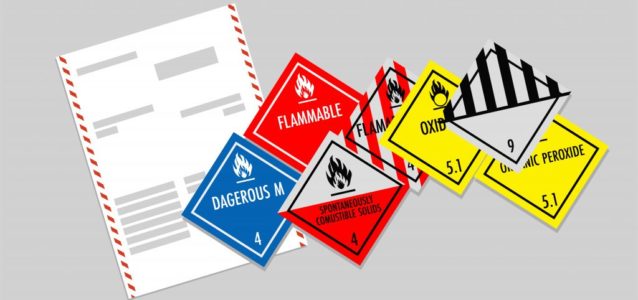Items with integral hazardous characteristics are classified as dangerous or hazardous goods. When shipping items that have been classified as such that if not properly controlled can cause health issues or hurt to those who are handling the goods in transit, which is irresponsible of the sender/owner. Thus the classification and shipping of hazardous goods needs to be done with utmost care.
The classification of hazardous goods are broken down based on the hazard in question as per the United Nations (UN) classifications whish are the following.
| Dangerous/Hazardous Goods Classifications | Class | Label Icon |
| Explosive Materials | Class 1 |  |
| Gases | Class 2 |  |
| Flammable Liquid | Class 3 |  |
| Flammable Solids | Class 4 |  |
| Oxidizing Substances/Organic Pesticides | Class 5 |  |
| Toxic/Infectious Substances | Class 6 |  |
| Radioactive Materials | Class 7 |  |
| Corrosive Materials | Class 8 |  |
| Miscellaneous | Class 9 |  |
Identify the Hazardous Goods
The process in shipping hazardous goods, first off identify the hazardous good, which includes understanding the makeup of the item. This is an important step as the shipper needs to understand what they are sending, as many things that are inconspicuous, can also be classified as dangerous or hazardous goods. These include the likes of table tennis balls, nail polish, paint, perfumes even though they do not contain dangerous components.
Air Travel Restrictions
The IATA (International Air Transport Association) have set regulations for transport of such goods via air travel as most dangerous goods are allowed for travel only via ground (which means that express shipping of hazardous goods is not possible). In addition, it should be noted, that certain dangerous or hazardous goods are banned in certain countries and as a shipper, one should know this before shipping. Whilst certain countries may allow certain goods, you should also know whether shipping networks or couriers are willing to carry them. In the event, you will not be able to use ignorance as a defense and may have to pay fines when not complying with the laws and regulations of the import country.
Careful Packing and Packaging
There are set regulations by the IATA that deem hazardous goods not being safe to travel via air freight, thus it’s usually carried out via sea freight. It is very important that each item is packed safely and properly to ensure the safety of cargo handlers and not causing damages or leakages that could cause a “situation” endangering living beings and properties. If the likes of hazardous and non-hazardous goods are being shipped together in the same shipping container the hazardous goods should be tightly and safely packed, braced in and secured for transport. It should also be placed in an area of the container that are accessible easily or quickly in the event of an emergency, such as closest to the container doors in for swift removal. Furthermore, it is vital that the necessary labels using IMDG code/UN number of the cargo be indicated clearly to easily access risk and level of danger from the cargo content.
Stay tuned for the next installment on Hazardous Goods and the Process of Shipping them!

